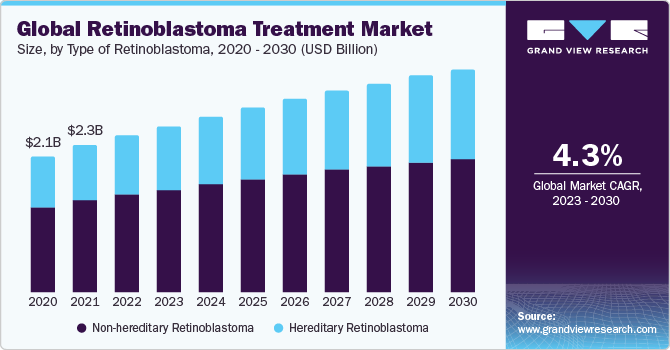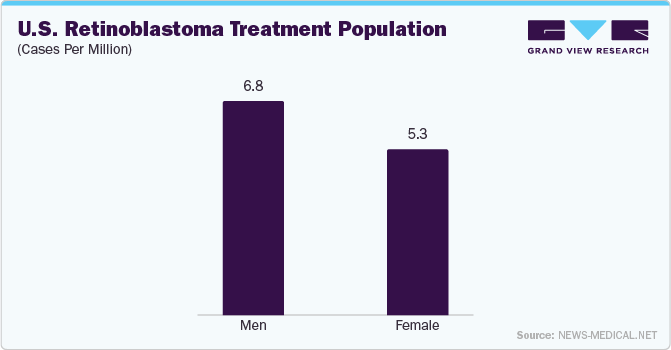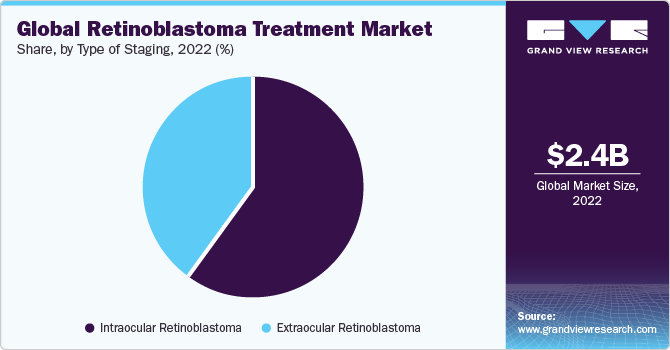
Retinoblastoma Treatment Market Size, Share & Trends Analysis Report, By Treatment Type (Surgery, Laser Therapy), By Type Of Retinoblastoma, By Type Of Staging, By Region, And Segment Forecasts, 2023 - 2030
- Report ID: GVR-4-68040-172-0
- Number of Report Pages: 100
- Format: PDF
- Historical Range: 2018 - 2021
- Forecast Period: 2023 - 2030
- Industry: Healthcare
Retinoblastoma Treatment Market Trends
The global retinoblastoma treatment market size was valued at USD 2.42 billion in 2022 and is expected to grow at a CAGR of 4.26% over the forecast period. This is attributed to the rising incidence of retinoblastoma, growing advancements in medical technology, and increasing number of research & development in the oncology fields. Moreover, the increasing number of funding and rising government initiatives for acknowledging the population is anticipated to further fuel the market growth from 2023 to 2030.

Furthermore, individuals with a background of hereditary retinoblastoma are highly anticipated to develop second primary tumors (SPT) unrelated to retinoblastoma. These often include lung cancer, bone sarcoma, various soft tissue sarcomas, leiomyosarcoma, malignant melanoma, and midline brain tumors. Moreover, it increases the risk of prevalent solid cancers such as bladder and breast cancer. Thus, the overall risk of SPT occurrence is approximately 36% within 40 years post-retinoblastoma diagnosis. Thereby, the treatment procedure for retinoblastoma plays a significant role in determining the magnitude of SPT risk as well.

Treatment Type Insights
Based on the treatment type, the chemotherapy segment held the largest market share in 2022. This is attributed to the increasing number of cases and rising continuous advancements in chemotherapy regimens & drugs. Furthermore, several pharmaceutical companies are highly investing in research & development to create more effective and direct chemotherapy agents for effective treatment of retinoblastoma with minimum adverse effects.
Type Of Retinoblastoma Insights
On the basis of the type of retinoblastoma, the market is segmented into non-hereditary retinoblastoma and hereditary retinoblastoma. The non-hereditary retinoblastoma segment dominated the market in 2022. Unlike many other cancers, retinoblastoma is not usually hereditary, meaning it doesn't run in families or pass from parents to their children through their genes. According to an NCBI article published in June 2023, non-hereditary retinoblastoma comprises 94% of the total cases. Thus, this is projected to boost the market segment over the forecast period.
Type Of Staging Insights
Based on the type of staging, the retinoblastoma treatment market is segmented into extraocular retinoblastoma and intraocular retinoblastoma. The extraocular retinoblastoma segment is expected to grow at the fastest CAGR over the forecast period. The diagnosis of extraocular retinoblastoma is challenging, and treatment usually involves a multidisciplinary approach, combining chemotherapy, radiation therapy, and potentially stem cell transplantation.

Regional Insights
North America dominated the market in 2022. A large patient pool and the presence of a well-established healthcare infrastructure are anticipated to further strengthen market growth in this region. According to the February 2022 publication by the American Society of Clinical Oncology, retinoblastoma constitutes 2% of all cancer diagnoses in children under 15 years old. Furthermore, approximately 200 to 300 children in the U.S. are believed to receive a diagnosis of retinoblastoma annually. The growing advancements in effective treatment, increased awareness, and early diagnostic initiatives are anticipated to fuel the growth of the region over the forecast period.
Asia-Pacific is expected to witness the fastest CAGR over the forecast period. Healthcare expenditure, improving healthcare infrastructure, and increasing prevalence of retinoblastoma are some factors that are anticipated to drive the Asia Pacific retinoblastoma treatment market.
Competitive Insights
Key players operating in the market are GlaxoSmithKline PLC, Baxter International, Inc., Johnson & Johnson, Pfizer, Inc., and Novartis AG among others. The market participants are constantly working towards new product development, R&D activities, and other strategic alliances to gain new market avenues.
The following are some instances of strategic initiatives:
-
In January 2022, Immunocore announced the FDA agreement of KIMMTRAK (tebentafusp-tebn) in the treatment of metastatic or unresectable uveal melanoma
-
In April 2022, Sandoz announced the introduction of its generic combined eyedrop, which contain brimonidine tartrate and timolol maleate in ophthalmic solution 0.2%/0.5%, to the U.S. market. This generic version, rated as AB, closely matches AbbVie's Combigan and is created to lower eye pressure in individuals with high eye pressure (ocular hypertension)
We are committed towards customer satisfaction, and quality service.
"The quality of research they have done for us has been excellent."




